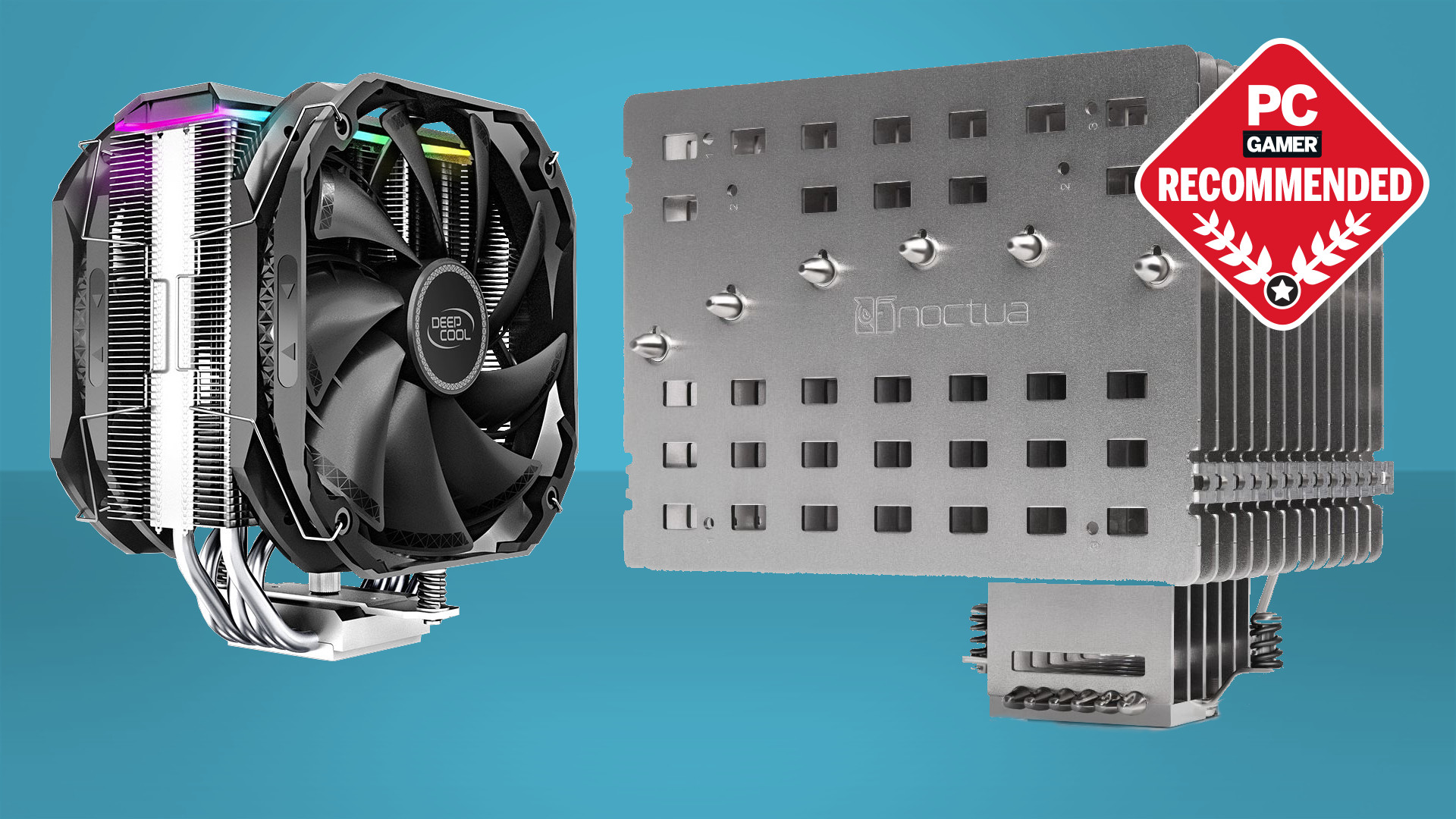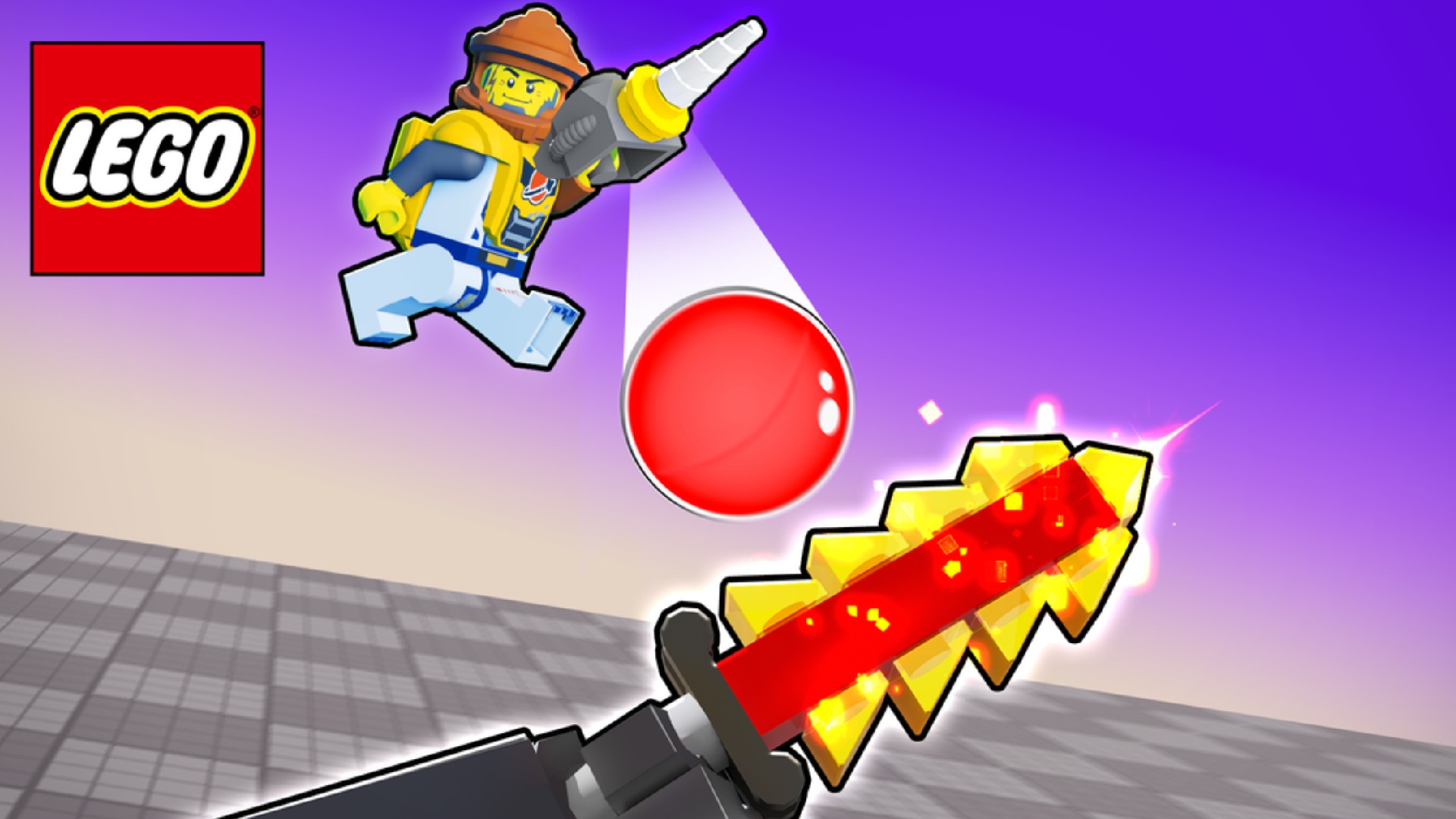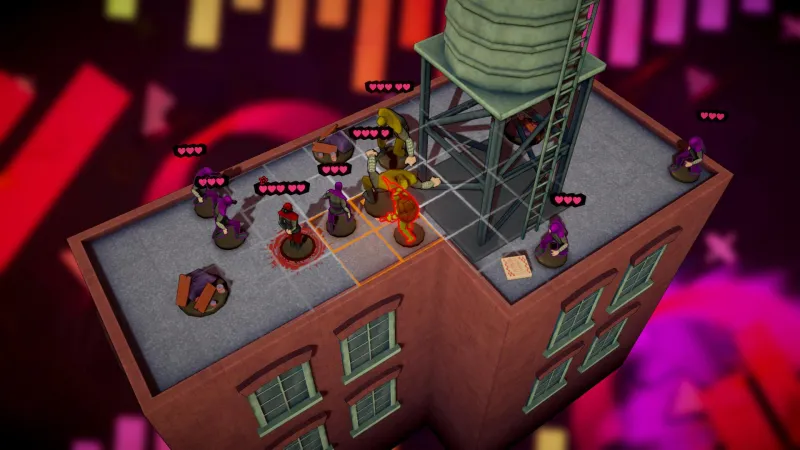
Keep your processor running cool and quiet with a nifty air cooler.
The best CPU air cooler will let you push your processor to the max without opting for a pricey, awkward liquid cooling system. There’s a lot to be said about the efficiency, affordability, and minimum fuss of a great CPU air cooler, so we’ve put together a list of the best air coolers to help keep your processor running smoothly.
In a world where CPU and graphics thermals are inextricably linked to their performance, insufficient cooling can not only tank performance but also affect the stability of your entire gaming rig. The most common and simplest solution is air cooling, but if you want to be fancy an all-in-one liquid cooler might be a good option, and will deliver super low temps at lower decibels.
There’s plenty to consider when looking for the best CPU air cooler. Generally, the ‘bigger is better’ rule flies here, but double check it’ll actually fit inside your PC case before you make a purchase. As an overclocker rigs with some flashy RGB. There is also a case to be made for using an air cooler in compact builds. Not only will it potentially save some space, but it could create more airflow over surrounding components on the motherboard, as well as providing cooling to the processor itself.
Below I have picked out six of the best CPU air coolers from the dozens I tested for the past year or so. I made sure to pick coolers for almost every budget that will fit different cases. This way, you’re not from choosing a very expensive option to only a slightly less expensive option.
Best CPU air cooler
(Image credit: DEEPCOOL)
The Deepcool AS500 received worthy attention when it was released, but the AS500 Plus with its additional fan elevates it to the point where it can compete with any single tower cooler on the market.
At the same time, it undercuts competitors in price. There aren’t many dual-fan ARGB supporting coolers at this price. Even if you spent double the money on a premium single tower cooler, your cooling performance won’t be a lot better.
Its cooling ability belies its compact dimensions. Only more expensive dual-tower coolers beat it, and even then, not by a whole lot. Its dual-fan design no doubt helps. It’s also surprisingly quiet. Even when pushed hard the cooler doesn’t get excessively loud.
It even comes with its own ARGB controller.
Cooling and low noise levels are welcome, then add to that great build quality and subtle ARGB good looks and there’s nothing to complain about. It even comes with its own ARGB controller, and there’s a white version too if you like.
The Deepcool AS500 Plus punches above its weight and price. It cools very well, stays quiet, offers great build quality, and has a subtle ARGB splash with its own controller. Finally, it offers great value for money relative to many dual-fan single tower coolers. Short of stressing it with a heavily overclocked high-end processor, the AS500 Plus ticks all the boxes and comes highly recommended.
(Image credit: DEEPCOOL)
If the brand name didn’t already give it away, the Be Quiet Pure Rock 2 really is quiet. It’s a single tower cooler equipped with the company’s highly regarded Pure Wings 2 PWM fan which carries a low 26.8 dB(A) noise rating. That means it’s very quiet indeed. It feels really solid too—an indicator of good build quality—and it comes in at a low price.
We wouldn’t describe the Pure Rock 2 as the most beautiful cooler on the market. But if you do have a windowed case, you could consider the black version which is certainly more attractive than the plain aluminum finish of the base version.
The Pure Rock 2 is primarily designed to cool; unseen and unheard. It’s rated to cool CPUs with a 150W TDP, though perhaps this is a touch optimistic, but that’s down to the CPU manufacturers and their ‘real’ TDPs. An Intel Core i5 12600K or AMD Ryzen 7 5800X shouldn’t present a problem for the Pure Rock 2.
For anything other than high-end CPUs, the Pure Rock 2 will keep your chip cool and quiet. If you’re not interested in bling and want something that’s a step up from bundled coolers, the Pure Rock 2 is a fantastic choice. It will cool out of sight, mind, and earshot.
(Image credit: Noctua)
The Noctua NH-D15 Chromax Black is considered by many to be the best air cooler on the market. We love it too, and it’s an easy inclusion on our list of recommended coolers.
It performs brilliantly and has excellent fans that are a welcome black color instead of that rather unsightly beige and brown (sorry, Jacob). Its build quality is fantastic and Noctua’s packaging, accessories, and documentation are second to none.
Really, only 360mm AIO coolers outperform it. If you want an air cooler that can handle any consumer CPU on the market, you might find one to match the Noctua flagship, but you won’t find anything that truly beats it.
Noctua has a long tradition of adding support for new sockets.
Under normal operation, the NH-D15 can be considered truly silent. When pushed hard it becomes louder than you might expect, such as you might get when hammering out an AVX load, but we don’t mind having some optional cooling headroom when you need it. Even a 5GHz+ Core i9 11900K will result in quiet running while gaming.
So why isn’t it number one on our list? Its expense, and the perhaps sheer size, are the only things that count against it.
Notably, Noctua has a long tradition of adding support for new sockets. An investment in an NH-D15 Chromax Black means you’ll have a top-shelf cooler that will last you for many years.
(Image credit: Cryorig)
The Cryorig C7 has been on the market for some time, but it’s still been updated to handle newer sockets. It’s perfect for a truly compact small form factor system thanks to its 47mm height and adherence to ‘keep-out’ zones, where it will not interfere in any way with other system components.
Because sometimes you want to make a tiny PC, and not every system needs to have a monstrous GPU attached to it. And when that’s the (mini-ITX) case you either have the option to stick with a low-end stock cooler, or a quality third party version, such as the Cryorig.
The C7 destroys the stock Intel cooler.
And the C7 destroys the stock Intel cooler. It’s rated for up to 100W, but to be fair is better suited to 65W class CPUs up to about six or eight cores. This leaves it a bit of headroom for turbo bursts and means you won’t see your chip throttling under sustained loads, either.
If you’re overclocking, or using a high core-count processor, you can give it a pass, but that’s to be expected. With the right CPU it will stay surprisingly quiet for its compact size. Its top flow design will help to cool the VRM and M.2 SSD, too, something that can be neglected in compact systems.
The Cryorig C7 is a niche cooler, no doubt about it, but for the tiniest builds, the cute little C7 does an admirable job. If you want a little bit of extra TDP headroom, there are copper and graphene-coated versions that feature TDP ratings of up to 125W, though they’re more expensive. The C7 is a great choice for the smallest form factor systems.
(Image credit: Noctua)
Noctua’s NH-P1 passive cooler is very much a niche product and one that fans of quiet computing have been looking forward to for some time. It’s expensive, bulky, and generally limited to CPUs in the 65W range. Sounds like a dud? Hell no. its appeal may be limited, but if you’re a user who values silence above anything else, then the NH-P1 will be exactly what you’re looking for.
The NH-P1 is capable of cooling even high-end CPUs using only natural convection. That’s sort of what makes it a big deal in the cooling world. It does this through a vastly disparate design from your usual chip chiller.
The NH-P1 also features a grid of cut-outs horizontally through the cooler design, which helps air flow naturally across the cooler and, importantly, sap away the heat transferred into the fins from the heat pipes.
The heat pipes are actually the longest along their horizontal axis.
The heat pipes are undoubtedly of major importance here. Sit the NH-P1 side-by-side with the NH-D15, and you’ll notice they’re oriented differently. The heat pipes are actually the longest along their horizontal axis, which impacts heat dispersion due to the reliance on gravity for a heat pipe to function.
The NH-P1 is a great match for something like an AMD 5700G. That way, you could omit a discrete GPU and play e-sport titles in silence. The NH-P1 will keep this class of CPU boosting to its max, but only if you have at least some airflow.
The chances are you have a rear case fan that’s just a few cm away from it anyway. You can still opt to attach a fan if you want. True passive cooling, without any system fans, would require dropping to 35W class CPUs.
The NH-P1 is built for a specific purpose. Fans of quiet computing will love it. If you sleep near your PC or run a lounge room media center, the NH-P1 will ensure that your PC is truly silent. Clearly, it’s not meant for everyone, though.
Read our full Noctua NH-P1 review.
(Image credit: Be Quiet)
Keeping your CPU cool is vital, but so is overall system cooling. A cooler like the Be Quiet Dark Rock TF 2 blows air downwards, which helps to keep toasty M.2 drives and your vital motherboard VRMs running cool. This is something that can often be overlooked in AIO-cooled systems that lack good airflow over the motherboard, particularly if you have a GPU heating up your speedy NVMe drives, too.
The Dark Rock TF2 performs much like other single tower air coolers and, although it is on the pricey side, it’s not unreasonably so given the inclusion of two high-quality fans. Its ability to mount a fan above or below the heatsink (or both) adds a lot of installation flexibility. You can use it in all kinds of systems from powerful gaming PCs through to compact SFF systems.
In the Be Quiet tradition, the Dark Rock TF 2 is very quiet, particularly under low loads, and with a rating of up to 230W, it can handle all modern CPUs, though heavy overclocking will really be beyond it.
Downward blowing coolers have fallen out of favor compared to tower coolers, but with one or more hot PCIe 4.0 SSDs to cool, a motherboard needs decent airflow too. The Dark Rock TF 2 can be thought of as a system cooler, and not just a CPU cooler.
CPU air cooler FAQ
Which is better, AIO or air cooler?
Anyone looking at picking a cooler for their rig asks this question: Air or water cooling? Water cooling tends to be viewed as the premium solution, but air cooling remains perfectly viable unless you’re into heavy overclocking with higher core count CPUs. Air coolers are generally cheaper, more reliable and simpler. Yes, they can be bulky relative to an AIO but radiators are also bulky and require large cases too. With air coolers you don’t have to worry about the (admittedly very small) possibility of leaks or pump failure. Noise levels are highly dependent on the fans used but if you choose wisely, there’s no reason an air cooler won’t be as quiet or even quieter than an AIO due to the lack of pump whir.
Are CPU air coolers effective?
A high TDP processor or CPU overclocking will require something big to absorb and dissipate all that heat. But a dual tower or dual fan model will be just as capable of cooling as an all-in-one liquid cooler.
If you want something quiet, a big cooler with a high cooling capacity will also suit, but pay attention to the noise levels and RPM rating of its fans. Then you get into things like your case size. You’ll need to go with a more compact cooler if you’re running a mini system, so look at the dimensions.
There’s also an argument to be made for downward blowers. The components around your CPU, such as the power circuitry and NVMe SSDs, can get hot and throttle if they’re not properly cooled. And with a liquid cooler they get no help, but a good downward blowing CPU air cooler will not just chill your processor, but other parts on the motherboard too.
How do I pick a CPU air cooler?
There’s so much to consider. It would be easy to simply go for the biggest one you can get, but that ignores case constraints, the TDP of your processor, your budget, and aesthetics. At least you can rest assured that our picks will serve you well with the appropriate accompanying hardware.
The best cooler is one that you can install in your particular rig, give it a stress test under a high heat load, tune the fan curves if necessary and then forget about it. RGB models excepted, a good quality air cooler is unseen and never draws attention. You know you’ve made a good choice when you’ve gone months happily gaming away or doing whatever it is you do on your system with barely a thought about your cooling.
What CPU sockets do air coolers work with?
Not all coolers support all CPU sockets. Cooling for AMD Threadripper CPUs can be tricky for example. Also, Intel 12th Gen LGA1700 compatibility is more and more important these days. So, if you’re planning on building an Alder Lake system, pay close attention to the list of supported sockets. Stock from earlier in 2021 will definitely lack support. You can expect manufacturers to offer compatible mounting kits and updated SKU’s but if you’re planning on upgrading to 12th Gen, make sure you check with the retailer or manufacturer to ensure your choice of cooler includes LGA 1700 support now, or if it will in the future.
Stay Cool Gamers!






